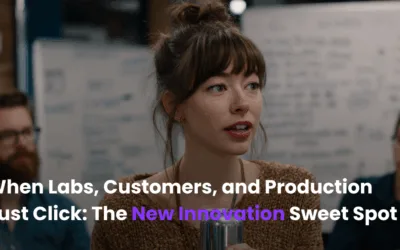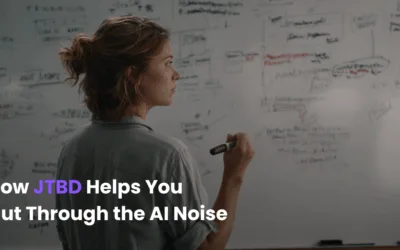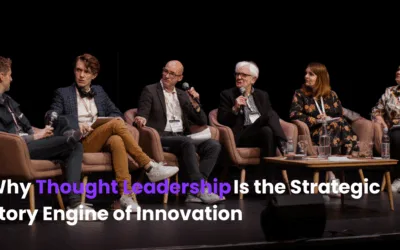Customer experience and innovation are often spoken about as strategic priorities but we rarely see the strategic, programmatic dedication required to shift the needle in most organisations. When we look at go-to-market strategies, most organisations focus their efforts around the safe centre of their Ideal Customer Profiles (ICPs). While this provides predictability, it often limits possibility.
But where is the real growth opportunity? It’s not at the centre. It’s at the edge – where bold ideas meet untapped customer needs and where innovation moves from abstract aspiration to meaningful impact.
Rethinking the ICP: The Edge is Where Insight Lives
Operating inside your comfort zone may deliver marginal gains, but leading innovators know that customer-centric innovation demands venturing beyond it. At the edge of your ICP are overlooked segments, fringe use cases, and unmet needs. These audiences may not check every traditional box, but they hold the power to reshape how your product is used, understood, and valued.
Nike’s FlyEase design – originally intended for athletes with disabilities – unlocked broader appeal across demographics and inspired loyalty far beyond their core audience. Similarly, LEGO Ideas created a new customer experience by inviting fans to co-create, building community alongside innovation.
Customer Experience Isn’t Static – It Evolves With Intentional Curiosity
To deliver exceptional customer experience, we must shift our mindset from meeting expectations to challenging them. That means asking better questions, running smarter experiments, and designing with curiosity.
At Disruptors Co, we embed this thinking in everything from AI Discovery Sprints to Innovation Labs – helping teams rapidly test, validate, and learn how to serve new audiences with precision and purpose. When leaders explore these edges, they often find underserved groups whose needs, once met, drive significant market expansion and differentiation.
Human-Led, AI-Powered: Building Transformative Customer Experiences
No matter how we feel about it, AI is no longer optional – and it’s a question of how, not when. Artificial intelligence is becoming a critical enabler of customer experience and innovation at all stages. From predicting unmet needs to generating hyper-personalised content, AI gives teams a powerful edge. But as we say at Disruptors Co: technology alone is not innovation.
The true magic happens when human insight co-designs with AI capability. It’s putting the human in the loop. Our approach to “innovation on purpose” ensures that every AI-driven interaction enhances – not replaces – the human connection that underpins trust and loyalty.
In fact, according to Gartner, 70% of organisations will use AI to assist productivity by 2025 (so right now!). The implication is clear: businesses not embedding AI into CX and GTM strategies are already behind.
Experimentation at the Edge Is a Growth Strategy, Not a Risk
Engaging audiences at the edge of your ICP isn’t reckless – it’s rigorous. It requires hypothesis-led marketing, inclusive design principles, and a culture that values learning as much as launching.
We’ve seen this play out in our work with scaleups and enterprise teams: those who embrace edge experimentation grow faster, build more inclusive experiences, and future-proof their brands. Some recent ecosystem mapping exercises saw one of our startup teams unearthing a whole new customer category with massive potential upside in terms of revenue and opportunity.
When designing a GTM Strategy we encourage:
- De-risking this process using real-time data
- Co-designing messaging with AI as well as customer advocates
- Building feedback loops to expand reach while staying aligned to business goals.
In Customer Experience and Innovation, Collaboration Is the Catalyst
Often, innovation at the edge begins with unlikely partnerships – between departments, between sectors, or between humans and machines. Breakthrough customer experiences emerge not from silos, but from synergy. Cross-pollinating perspectives creates solutions that are not just new – but necessary.
Sephora’s Innovation Lab, launched in 2015, built a team of executives hired from the marketing, product development, and technology industries to source, develop, evaluate, test, and ultimately launch new offerings and technologies for shopping in the store and online. With a focus on experimentation, the lab saw the emergence of a new, personalised beauty experience, incorporating a range of tech:
- Computer Vision Models: AI identifies key facial features such as eyes, lips, and skin tone to apply virtual products accurately.
- Augmented Reality (AR): The AR component overlays virtual makeup on the customer’s face using real-time camera input.
- Recommendation Engines: AI suggests complementary products based on the customer’s preferences and interactions with the tool.
By bringing together a diverse range of talent and technologies, Sephora created a space where collisions of context could create the space for new thinking and scalable, inclusive customer strategies.
Make the Edge Your Next Advantage
What we’ve learned over the last decade, working with big brands and small, is that innovation doesn’t happen by accident – it’s the result of intentional design, continuous testing, and the courage to step outside what’s worked before. To truly lead in customer experience and innovation, you need to be where most competitors aren’t looking: at the edge of the market, co-creating with the customers you haven’t met yet.
Key Takeaways:
- The Edge of the ICP Is the Opportunity Zone
- Customer Experience and Innovation Must Be Designed Together
- AI Is a CX Multiplier, Not a Replacement
- Experimentation Is a Strategy, Not a Gamble.



